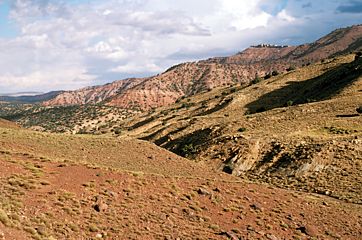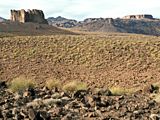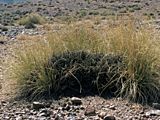Atlas Mountains (Morocco)
The Giant and Central Atlas as well as the southern front ranges (Sahara and Anti-Atlas) are in a transition zone between the Mediterranean and the Saharan (subtropical) climate. The alpine belt above the juniper treeline in the central parts is dominated by tussock grasses and hemisphere-shaped shrubs, largely belonging to Asteraceae and Euphorbiaceae. Winters are cold and snow is common, but summers are long and very dry, hence the vegetation is commonly very sparse. A forest cover is missing in the southern ranges (too dry), hence the alpine belt is poorly defined.
3 -
Typical halfa grass high elevation steppe at 1400-1800 m elevation, below of what would
be alpine in terms of climate.
4 -
Stipa tenesissima
(Poaceae), "halfa", the most prominent tussock grass (compare the similar vegetation on
Mexican volcanoes).
5 -
"Hedgehog" shape cushion plants
(Helichrysum sp.,
see
Mt. Kilimanjaro
and
Australia).
6 -
Thorny cushions - a response to millenia of
pastoralism
(Asteraceae).







